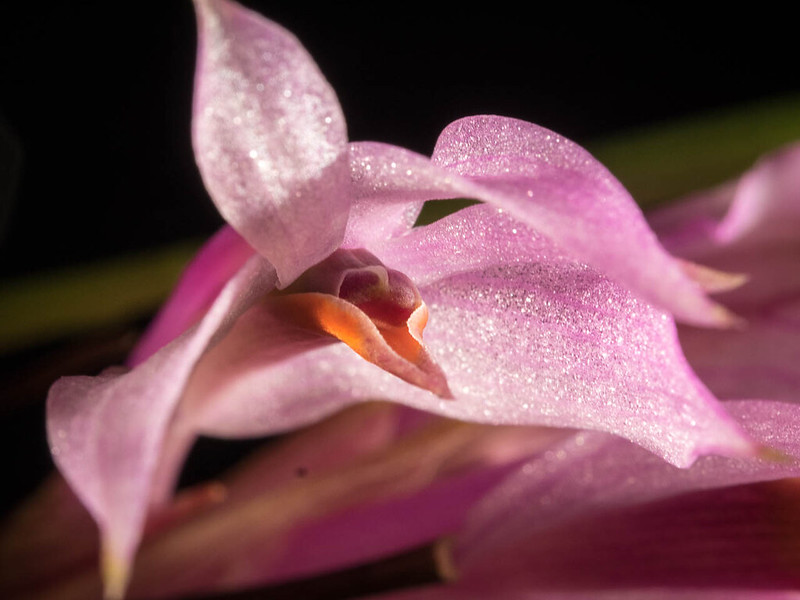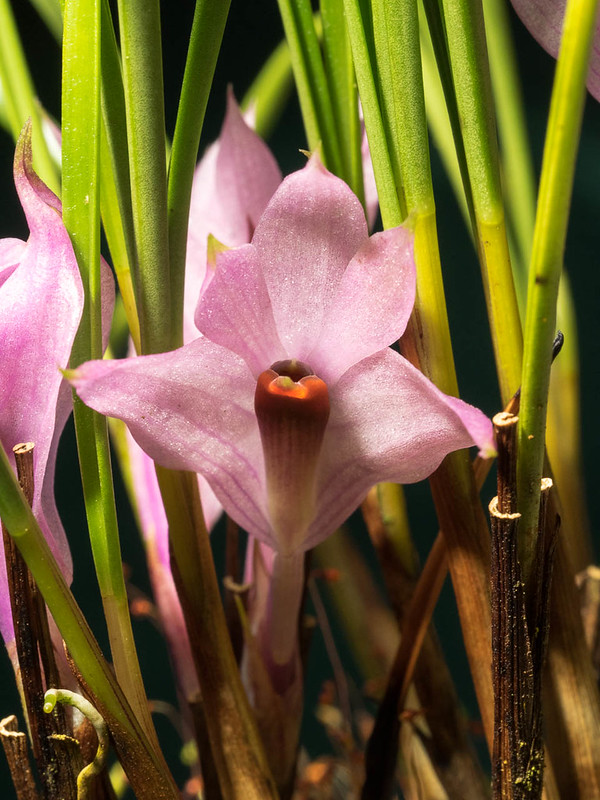
Dendrobium violaceum occurs in the island of New Guinea. Although it is one of the largest species within this group of Dendrobium section Oxyglossum, the height of the plant is less than 30cm, and mine is about 15-20cm. Two subspecies are recognized; D. v. subsp. violaceum and D. v. subsp. cyperifolium (Reeve and Woods 1989). D. v. subsp. violaceum has leaves which are 2-11mm wide, and occurs throughout New Guinea (elevations of 750-2000m). D. v. subsp. cyperifolium is recognized by its narrow leaves of 0.75-2mm wide, and it occurs mainly in the western and northern parts of the island (elevations of 1200-1850m). You can see the distribution map of the two subspecies in this link.


A side note about Dendrobium section Oxyglossum:
Dendrobium is one of the largest genera in Orchid family (Orchidaceae), and several sections were proposed within the genus in order to clarify the evolutionary relationship. However, the traditional sections, based on morphologies, turned out to be a little messy, and some sections do not represent the evolutionary relationship well. Researchers have been working on a more coherent classification with the help of molecular phylogeny. Dendrobium violaceum is in the section Oxyglossum, whose center of species diversity is in the island of New Guinea. Reeve and Woods (1989) proposed to combine the section Cuthbertsonia into the section Oxyglossum. More recently, it turned out that these two sections were somewhat distantly related groups, so it is not a good idea to combine (Clements 2003, Takamiya et al 2014). The original section Oxyglossum without Cuthbertsonia is a good unit since the members do share the ancestor (monophyletic). In the studies, only 4 species of the section Oxyglossum were used (D. cyanocentrum, D. subuliferum, D. violaceum, D. masarangense subsp. theionanthum). Further, molecular data suggest that it may be reasonable to include an additional species such as D. rarum (section Pedilonum) in the section Oxyglossum. The three species, D. cuthbertsonii, D. laevifolium, and D. prasinum, in the section Cuthbertsonia are grouped with D. bracteosum (Clements 2003, Takamiya et al. 2014), and these four species are further grouped with species mostly from the section Calyptochilus. Indeed, the larger group, in which the sections Oxyglossum and Cuthbertsonia belong, is a big mess with several sections (e.g. Pedilonum and Calyptochilus as well as possibly Calcarifera and Dolichocentrum) intermingled within it. The largest problem is the section Pedilonum, which contains many distantly related groups. This mess is partly due to convergent evolution, where similar morphological characters evolved independently multiple times (Takamiya et al. 2014). Unfortunately, the relationships within this larger group is not well understood (the molecular data isn't large enough), so we have to wait for the appropriate classification of this group (Schuiteman 2012).
Some people seem to be able to grow this species fairly warm, but I grow it in cool-cold environment: 20C (68F) day, 10C (50F) night (see the bottom of this page for the details of my culture condition). I purchased this plant from Far East Agriculture of Malaysia in 2015.


Literature cited:
- Clements, M.A. 2003. Molecular phylogenetic systematics of the Dendrobiinae (Orchidaceae), with emphasis on Dendrobium section Pedilonum. Telopea 10(1): 247–298 (link to PDF)
- Reeve, T. M. and Woods, P. J. B. 1989. A revision of Dendrobium section Oxyglossum (Orchidaceae). Notes from the Royal Botanic Gardedn Edinburgh 46 (2): 161–305.
- Schuiteman, A. 2012. Typification of infrageneric taxa in Dendrobium (Orchidaceae). Muelleria 30(1): 3-7 (link 1 from Research Gate, PDF: link 2)
- Takamiya, T., Wongsawad, P., Sathapattayanon, A., Tajima, N., Suzuki, S., Kitamura, S., Shioda, N., Handa, T., Kitanaka, S., Iijima, H. and Yukawa, T., 2014. Molecular phylogenetics and character evolution of morphologically diverse groups, Dendrobium section Dendrobium and allies. AoB Plants, 6, p.plu045. (link to full text)
Comments
Post a Comment